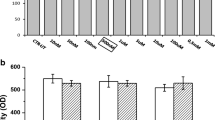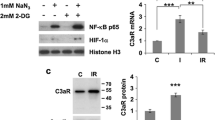Abstract
Mature mouse oligodendrocytes (OLs) are susceptible to death in demyelinating diseases such as multiple sclerosis and in brain injury following neurotrauma, ischemia, or stroke. To understand mechanisms leading to death of mature OLs and develop strategies for protection, we utilized cultures of mature mouse OLs to investigate the role of caspases and calpains in OL cell death mediated by different mechanisms. The agents used were (i) staurosporine, which induces apoptotic death via inhibition of protein kinases; (ii) kainate, which activates non-NMDA glutamate receptors; (iii) thapsigargin, which releases intracellular calcium stores; and (iv) SNAP, which releases active NO species and causes necrotic cell death. Inhibitors blocking primary effector caspases (including caspase 3), the FAS (death receptor)-mediated initiator caspases (including caspase 8), and stress-induced caspases (including caspase 9), were tested for their protective effects. Inhibition of caspases 3, 8, and 9 each robustly protected OLs following insult with staurosporine, thapsigargin, or kainate when added at optimal times. The time of addition of the inhibitors for maximal protection varied with the agent, from 1 h of preincubation before addition of staurosporine to 6 h after addition of kainate. Much less protection was seen for the NO generator SNAP under any condition. The role of calcium in OL death in each model was investigated by chelating extracellular Ca++ with EGTA, and by inhibiting the Ca++-activated calpain proteases. Calcium chelation did not protect against staurosporine, but decreased OL death initiated by kainate, thapsigargin, or NO. The calpain inhibitors PD150606 and calpain inhibitor I protected from cell death initiated by staurosporine, kainate, and thapsigargin, but not from cell death initiated by the NO donor SNAP.
Similar content being viewed by others
REFERENCES
Kruman, I., Guo, Q., and Mattson, M. P. 1998. Calcium and reactive oxygen species mediate staurosporine-induced mitochondrial dysfunction and apoptosis in pc12 cells. J. Neurosci. Res. 51:293–308.
Benjamins, J. A. and Nedelkoska, L. 1996. Release of intracellular calcium stores leads to retraction of membrane sheets and cell death in mature mouse oligodendrocytes. Neurochem. Res. 21:471–479.
Fern, R. and Moller, T. 2000. Rapid ischemic cell death in immature oligodendrocytes: A fatal glutamate release feedback loop. J. Neurosci. 20:34–42.
Tekkok, S. B. and Goldberg, M. P. 2001. AMPA/kainate receptor activation mediates hypoxic oligodendrocyte death and axonal injury in cerebral white matter. J. Neurosci. 21:4237–4248.
Yoshioka, A., Bacskai, B., and Pleasure, D. 1996. Pathophysiology of oligodendroglial excitotoxicity. J. Neurosci. Res. 46: 427–437.
Yoshioka, A., Shimizu, Y., Hirose, G., Kitasato, H., and Pleasure, D. 1998. Cyclic amp-elevating agents prevent oligodendroglial excitotoxicity. J. Neurochem. 70:2416–2423.
Itoh, T., Reddy, U. R., Stern, J. L., Chen, M., Itoh, A., and Pleasure, D. 2000. Diminished calcium homeostasis and increased susceptibility to excitotoxicity of JS 3/16 progenitor cells after differentiation to oligodendroglia. Glia. 31:165–180.
Kavanaugh, B., Beesley, J., Itoh, T., Itoh, A., Grinspan, J., and Pleasure, D. 2000. Neurotrophin-3 (nt-3) diminishes susceptibility of the oligodendroglial lineage to AMPA glutamate receptor-mediated excitotoxicity. J. Neurosci. Res. 60:725–732.
Boullerne, A. I., Nedelkoska, L., and Benjamins, J. A. 2001. Role of calcium in nitric oxide-induced cytotoxicity: EGTA protects mouse oligodendrocytes. J. Neurosci. Res. 63:124–135.
Mitrovic, B., Ignarro, L. J., Vinters, H. V., Akers, M. A., Schmid, I., Uittenbogaart, C., and Merrill, J. E. 1995. Nitric oxide induces necrotic but not apoptotic cell death in oligodendrocytes. Neuroscience 65:531–539.
Green, D. R. 1998. Apoptotic pathways: The roads to ruin. Cell 94:695–698.
Dyer, C. A. and Benjamins, J. A. 1990. Glycolipids and transmembrane signaling: Antibodies to galactocerebroside cause an influx of calcium in oligodendrocytes. J. Cell Biol. 111:625–633.
McCarthy, K. D. and de Vellis, J. 1980. Preparation of separate astroglial and oligodendroglial cell cultures from rat cerebral tissue. J. Cell Biol. 85:890–902.
Bottenstein, J. E. 1986. Growth requirements in vitro of oligodendrocyte cell lines and neonatal rat brain oligodendrocytes. Proc. Natl. Acad Sci. USA 83:1955–1959.
Benjamins, J. A. and Nedelkoska, L. 1994. Maintenance of membrane sheets by cultured oligodendrocytes requires continuous microtubule turnover and golgi transport. Neurochem. Res. 19:631–639.
Paschen, W. and Frandsen, A. 2001. Endoplasmic reticulum dysfunction: A common denominator for cell injury in acute and degenerative diseases of the brain? J. Neurochem. 79:719-725.
Single, B., Leist, M., and Nicotera, P. 2001. Differential effects of bcl-2 on cell death triggered under atp-depleting conditions. Exp. Cell Res. 262:8–16.
Studzinski, D. M. and Benjamins, J. A. 2001. Cyclic amp differentiation of the oligodendroglial cell line N20.1 switches staurosporine-induced cell death from necrosis to apoptosis. J. Neurosci. Res. 66:691–697.
Kruman, I. I. and Mattson, M. P. 1999. Pivotal role of mitochondrial calcium uptake in neural cell apoptosis and necrosis. J. Neurochem. 72:529–540.
Nakagawa, T. and Yuan, J. 2000. Cross-talk between two cysteine protease families: Activation of caspase-12 by calpain in apoptosis. J. Cell Biol. 150:887–894.
Nakagawa, T., Zhu, H., Morishima, N., Li, E., Xu, J., Yankner, B. A., and Yuan, J. 2000. Caspase-12 mediates endoplasmicreticulum-specific apoptosis and cytotoxicity by amyloid-beta. Nature 403:98–103.
Pike, B. R., Zhao, X., Newcomb, J. K., Wang, K. K., Posmantur, R. M., and Hayes, R. L. 1998. Temporal relationships between de novo protein synthesis, calpain and caspase 3-like protease activation, and DNA fragmentation during apoptosis in septo-hippocampal cultures. J. Neurosci. Res. 52:505–520.
Volpe, J. J. 2001. Neurobiology of periventricular leukomalacia in the premature infant. Pediatr. Res. 50:553–562.
Oka, A., Belliveau, M. J., Rosenberg, P. A., and Volpe, J. J. 1993. Vulnerability of oligodendroglia to glutamate: Pharmacology, mechanisms, and prevention. J. Neurosci. 13:1441–1453.
Matute, C., Alberdi, E., Domercq, M., Perez-Cerda, F., Perez-Samartin, A., and Sanchez-Gomez, M. V. 2001. The link between excitotoxic oligodendroglial death and demyelinating diseases. Trends Neurosci. 24:224–230.
Matute, C., Domercq, M., Fogarty, D. J., Pascual de Zulueta, M., and Sanchez-Gomez, M. V. 1999. On how altered glutamate homeostasis may contribute to demyelinating diseases of the CNS. Adv. Exp. Med. Biol. 468:97–107.
Werner, P., Pitt, D., and Raine, C. S. 2000. Glutamate excitotoxicity: A mechanism for axonal damage and oligodendrocyte death in multiple sclerosis? J. Neural. Transm. Suppl. 60:375–385.
Sanchez-Gomez, M. V. and Matute, C. 1999. Ampa and kainate receptors each mediate excitotoxicity in oligodendroglial cultures. Neurobiol. Dis. 6:475–485.
Matute, C., Sanchez-Gomez, M. V., Martinez-Millan, L., and Miledi, R. 1997. Glutamate receptor-mediated toxicity in optic nerve oligodendrocytes. Proc. Natl. Acad. Sci. U.S.A. 94:8830–8835.
Alberdi, E., Sanchez-Gomez, M. V., Marino, A., and Matute, C. 2002. Ca(2+) influx through ampa or kainate receptors alone is sufficient to initiate excitotoxicity in cultured oligodendrocytes. Neurobiol. Dis. 9:234–243.
Yoshioka, A., Yamaya, Y., Saiki, S., Kanemoto, M., Hirose, G., Beesley, J., and Pleasure, D. 2000. Non–N-methyl-D-aspartate glutamate receptors mediate oxygen: Glucose deprivation-induced oligodendroglial injury. Brain Res. 854:207-215.
Yoshioka, A., Yamaya, Y., Saiki, S., Kanemoto, M., Hirose, G., and Pleasure, D. 2000. Cyclic gmp/cyclic gmp-dependent protein kinase system prevents excitotoxicity in an immortalized oligodendroglial cell line. J. Neurochem. 74:633–640.
Follett, P. L., Rosenberg, P. A., Volpe, J. J., and Jensen, F. E. 2000. Nbqx attenuates excitotoxic injury in developing white matter. J. Neurosci. 20:9235–9241.
Jamin, N., Junier, M. P., Grannec, G., and Cadusseau, J. 2001. Two temporal stages of oligodendroglial response to excitotoxic lesion in the gray matter of the adult rat brain. Exp. Neurol. 172:17–28.
Liu, W., Liu, R., Chun, J. T., Bi, R., Hoe, W., Schreiber, S. S., and Baudry, M. 2001. Kainate excitotoxicity in organotypic hippocampal slice cultures: Evidence for multiple apoptotic pathways. Brain Res. 916:239–248.
Thastrup, O., Cullen, P. J., Drobak, B. K., Hanley, M. R., and Dawson, A. P. 1990. Thapsigargin, a tumor promoter, discharges intracellular Ca2+ stores by specific inhibition of the endoplasmic reticulum Ca2+-ATPase. Proc. Natl. Acad. Sci. U.S.A. 87:2466–2470.
Bitko, V. and Barik, S. 2001. An endoplasmic reticulum-specific stress-activated caspase (caspase-12) is implicated in the apoptosis of a549 epithelial cells by respiratory syncytial virus. J. Cell Biochem. 80:441–454.
Rao, R. V., Hermel, E., Castro-Obregon, S., del Rio, G., Ellerby, L. M., Ellerby, H. M., and Bredesen, D. E. 2001. Coupling endoplasmic reticulum stress to the cell death program: Mechanism of caspase activation. J. Biol. Chem. 276:33869–33874.
McColl, K. S., He, H., Zhong, H., Whitacre, C. M., Berger, N. A., and Distelhorst, C. W. 1998. Apoptosis induction by the glucocorticoid hormone dexamethasone and the calcium-atpase inhibitor thapsigargin involves bc1-2 regulated caspase activation. Mol. Cell Endocrinol. 139:229–238.
Bredesen, D. E. 2000. Apoptosis: Overview and signal transduction pathways. J. Neurotrauma. 17:801–810.
Zimmermann, K. C., Bonzon, C., and Green, D. R. 2001. The machinery of programmed cell death. Pharmacol. Ther. 92: 57–70.
Feng, G. and Kaplowitz, N. 2002. Mechanism of staurosporine-induced apoptosis in murine hepatocytes. Am. J. Physiol. Gastrointest. Liver Physiol. 282:G825–G834.
Stepczynska, A., Lauber, K., Engels, I. H., Janssen, O., Kabelitz, D., Wesselborg, S., and Schulze-Osthoff, K. 2001. Staurosporine and conventional anticancer drugs induce overlapping, yet distinct pathways of apoptosis and caspase activation. Oncogene 20:1193–1202.
Lopez, E. and Ferrer, I. 2000. Staurosporine-and h-7-induced cell death in sh-sy5y neuroblastoma cells is associated with caspase-2 and caspase-3 activation, but not with activation of the fas/fas-I-caspase-8 signaling pathway. Brain Res. Mol. Brain Res. 85:61–67.
Gu, C., Casaccia-Bonnefil, P., Srinivasan, A., and Chao, M. V. 1999. Oligodendrocyte apoptosis mediated by caspase activation. J. Neurosci. 19:3043–3049.
Tang, D., Lahti, J. M., and Kidd, V. J. 2000. Caspase-8 activation and bid cleavage contribute to mcf7 cellular execution in a caspase-3-dependent manner during staurosporine-mediated apoptosis. J. Biol. Chem. 275:9303–9307.
Fujita, E., Egashira, J., Urase, K., Kuida, K., and Momoi, T. 2001. Caspase-9 processing by caspase-3 via a feedback amplification loop in vivo. Cell Death Differ. 8:335–344.
Viswanath, V., Wu, Y., Boonplueang, R., Chen, S., Stevenson, F. F., Yantiri, F., Yang, L., Beal, M. F., and Andersen, J. K. 2001. Caspase-9 activation results in downstream caspase-8 activation and bid cleavage in 1-methyl-4-phenyl-1,2,3,6-tetrahydropyridine-induced parkinson's disease. J. Neurosci. 21:9519–9528.
Moore, J. D., Rothwell, N. J., and Gibson, R. M. 2002. Involvement of caspases and calpains in cerebrocortical neuronal cell death is stimulus-dependent. Br. J. Pharmacol. 135:1069–1077.
Oppenheim, R. W., Flavell, R. A., Vinsant, S., Prevette, D., Kuan, C. Y., and Rakic, P. 2001. Programmed cell death of developing mammalian neurons after genetic deletion of caspases. J. Neurosci. 21:4752–4760.
Author information
Authors and Affiliations
Corresponding author
Rights and permissions
About this article
Cite this article
Benjamins, J.A., Nedelkoska, L. & George, E.B. Protection of Mature Oligodendrocytes by Inhibitors of Caspases and Calpains. Neurochem Res 28, 143–152 (2003). https://doi.org/10.1023/A:1021612615554
Issue Date:
DOI: https://doi.org/10.1023/A:1021612615554




